Insurmountable Review
Fast Facts
Insurmountable
Developer: ByteRockers’ Games
Publisher: ByteRockers’ Games
Website: https://www.byterockers.games/insurmountable?lang=en
Genre(s): Adventure, Indie, Simulation, Strategy
Platform: PC
Age Rating: PEGI 7
Release Date: 29/4/2021
Price: £15.49
A code was provided for review purposes
Mountain climbing is no joke. On an average climb, you’ll have to come well-prepared with the right equipment and a solid level of fitness. But for much grander adventures, an unshakeable will and strong constitution will be needed to see you all the way to the mountain’s peak. It sounds exciting, but who can be bothered with all the effort? let alone the potential risk of death at greater, more dangerous heights. Thankfully, Insurmountable brings the mountaineering experience to you, where you can reach the highest peaks from the safety of your own home. But while it tries to emulate the excitement and intensity of a treacherous mountain climb, Insurmountable stumbles a little too often for it to succeed.
A Gentle Hike
The simplicity of Insurmountable’s gameplay is definitely one of the few areas where the game shines. Most of your time will be spent guiding your mountaineer up towards the peak through point and click controls. Selecting a tile will send your character over to that tile, but by selecting multiple tiles, you can plan out your own route. This is incredibly beneficial to your run if you are able to chain together various world events that can net you some useful bonuses for the rest of your ascent; but I’ll speak more about these later.
The core experience is also enhanced by other systems that add a little more depth to Insurmountable’s otherwise basic gameplay. Items can be obtained throughout your journey which can boost your survival meters and also negate the effects of harsh weather and environmental dangers. However, you can only hold so many items before your backpack is full. This means you will need to perform a little inventory management from time to time, which is a good way of keeping on your toes. However, in my experience, this never really becomes an issue due to how little I received such items.
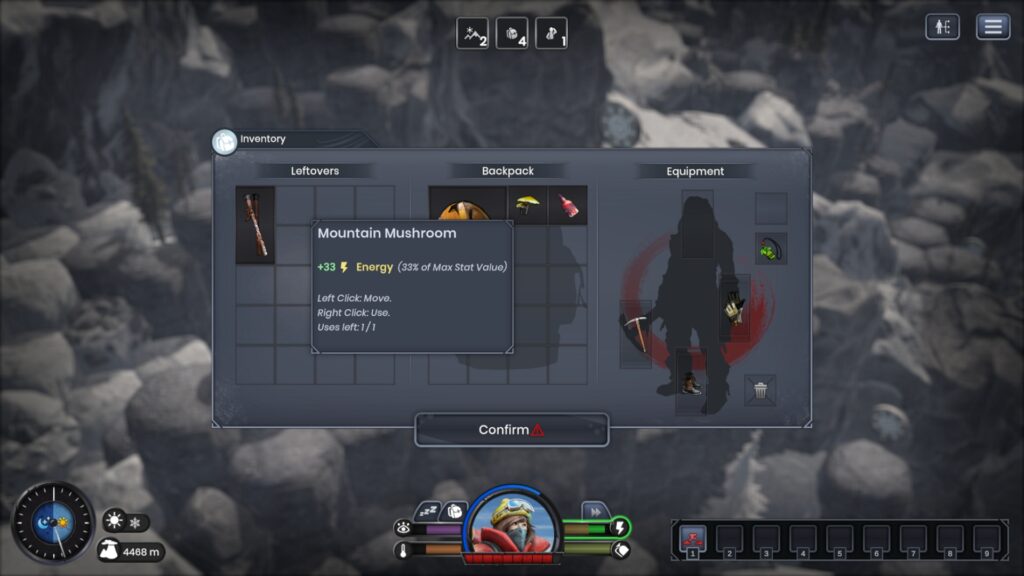
This is accompanied by a fairly straightforward levelling system that provides the player with passive and active perks. These perks are gained by levelling up through events and offer a myriad of ways to make your journey feel a bit safer. Passive perks will provide bonuses to your character that last the entirety of your run. These can include things such as reduced energy cost when traversing ice or snow, or even a small increase to one of your survival meters. Active perks are more like abilities that must be activated to receive their benefits. One such ability allowed me to ignore any movement penalties when crossing over rocky terrain, and another even let me exchange some of my warmth for oxygen.
The easy-going nature of Insurmountable’s gameplay made it feel incredibly user-friendly; particularly in the early parts of a climb that felt quite relaxing. Yet even though it gives more hardcore players room to further optimise their experience, it is certainly not required or encouraged; at least on the lower difficulties. Actually playing the game is relatively undemanding due to how all of the game’s various systems feel like shadows of what they could be. This is something which may be disappointing for players looking for a heavily detailed gameplay experience. However, while I wish there were a little more depth to the core gameplay experience, the simplicity and strong synergy between all of Insurmountable’s various systems make for a game that is accessible and welcoming to all players; making it a great game to pass some time.
An Eventful Journey
As I previously mentioned, certain tiles will have an event located on them. Events can range from friendly chit-chats with fellow climbers to mysterious encounters with shadowy figures. There are even ‘natural phenomena” events that are particularly interesting and unique, and offer the chance to replenish a diminishing meter in bulk. Participating in as many events as you can is crucial to your survival, as the further you progress, the greater the risk of death becomes. Thankfully nearly all of these events offer you the chance to gain an item or a much-needed breath of fresh air; quite literally at times. In my first run, I didn’t go to many of these events, which honestly gave me a tougher time towards the end of my first mountain. I learned that something as simple as stopping in a cave to rest is just as important as gaining an oxygen tank from a crashed plane; and it’s an invaluable lesson I carried with me in future runs.
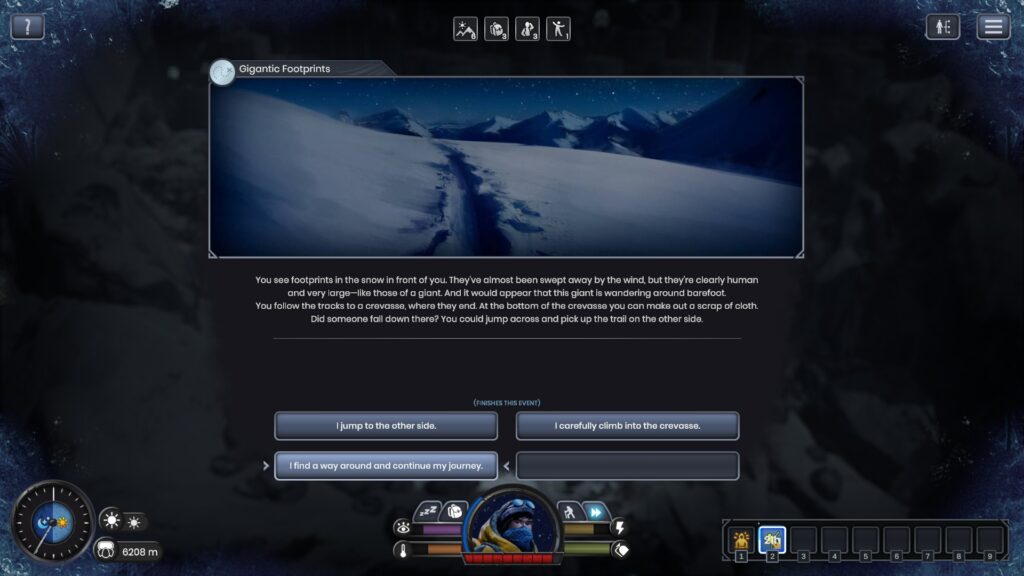
But while events try to be both a useful and engaging gameplay feature, they never seemed to fulfil their latter purpose. At first, they were pretty cool, with neat little stories like these doing a great job of keeping my attention. I came across a mysterious side plot that alluded to a yeti in the mountains, and a tragic tale of two sons having to bury their father. I felt increasingly encouraged to go over more of these events due to these narratives. However, the feeling was short-lived. I soon realised that there was little variety in the events I could encounter. I’d be going up a different mountain and still be coming across the same kind old woman or majestic bald eagle I did when scaling the last one. At a certain point in my second run, I even had the same event occur three times in a row. Before long I was going over events purely out of necessity, and the value they added to my playthrough beyond their functionality was null and void.
Occupational Hazard
You’ll start your playthrough of Insurmountable by first choosing from three different characters. Each comes with their own unique ability and starting equipment that benefits your run in a variety of ways. The scientist comes armed with a tent and hiking staff, making them a great option for an easy start; the journalist comes with heavy boots and a climbing axe, making them surprisingly great at scaling the upper regions of the mountains; and the adventurer is really just there for the experience, bringing along a tent, some climbing gloves, and a can of beans to keep their energy levels up. Sadly, this is where the distinction between characters comes to an end, aside from their individual backstories and jacket colours.
No matter who I played the experience always felt the same. You’d think that they’d each have their own unique strengths that would be reflected in their perk options. However, I always had access to the same perks each run. There was just no real variety to playing a different run with a different character. Picking who I wanted to play ultimately felt like a choice of what I wanted my character to look like; which was even more redundant than their backstories.
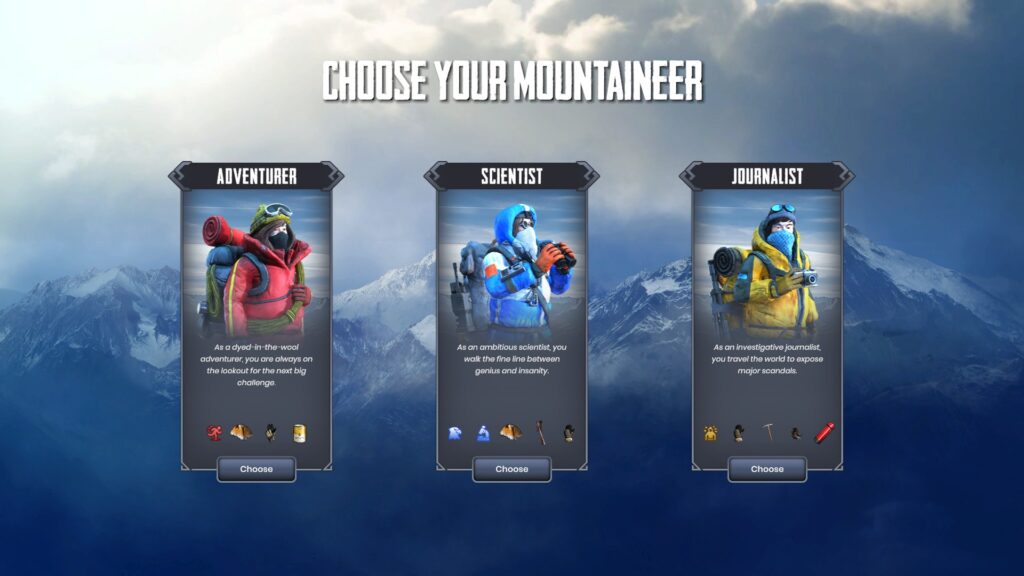
The character backstories proved to be rather compelling. The scientist believes that at the peak of the mountains lies some form of undiscovered electromagnetic energy source; and the journalist is out in search of the scoop of a lifetime, with rumours of secret experiments and missing people leading them up to each mountain. While the other two have quite serious stories at play, the adventurer is merely there for the sake of being there, hoping to take on some of the toughest mountains in their life. But given the incredibly high risk of death and lack of a Pulitzer prize at the finish, you can’t help but wonder if they should’ve sat this adventure out.
The characters’ motivations and narratives do make you feel more invested in a playthrough, but I’d be lying if I said they actually mattered. In my run as a journalist, I never felt as though my story and motivation for climbing these mountains ever existed. Most of my time playing the game was actually quite uneventful, and to put it simply, quiet. I’d be skipping through events to get items, and I’d only ever get an update to my character’s story when I’d reached the peak of a mountain. By the time I was presented with a story update, I couldn’t really be bothered reading through it all, purely because of how inconsequential it was to the overall experience. So while Insurmountable attempts to keep you invested with the openings of what appears to be rich character backstories, the characters themselves never feel too distinct, and their narratives are quickly forgotten thanks to them being more absent than present.
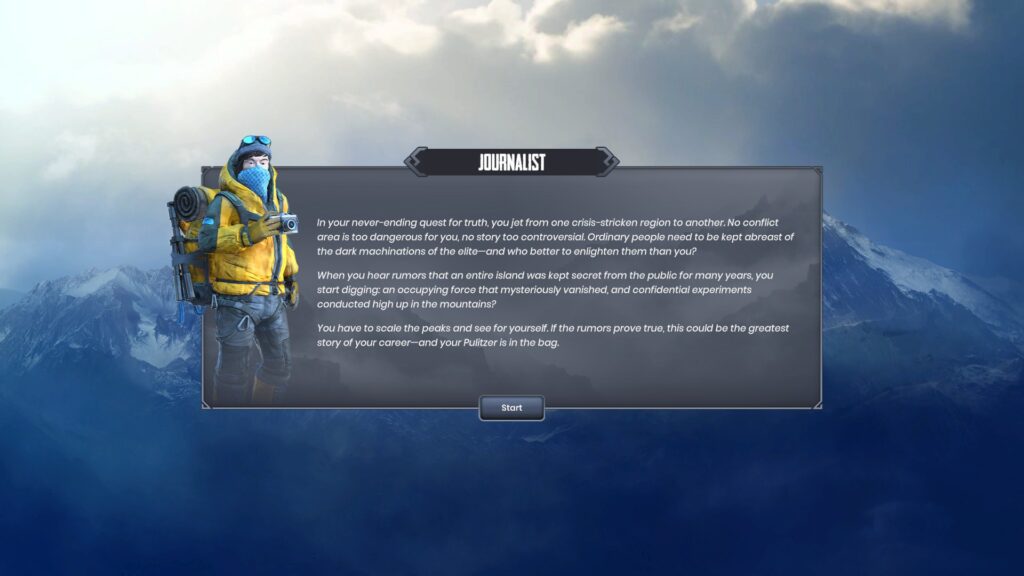
Tougher Than You Think
The base of the mountain may feel like a breeze at the start of a run, but Insurmountable knows exactly how to turn that into a violent tornado. It incorporates key survival elements that play a big role in making the game as challenging as it is. Firstly, you’ll want to watch your survival meters. These include your energy, sanity, warmth, and oxygen. Should any one of these reach zero, you’ll be at greater risk of encountering critical events. These can prove fatal should you fail both to make the right choice and to get your depleted meter back above zero – and should you let your health drop too far, it’s game over.
On my first run on normal difficulty, I didn’t expect the level of challenge the game threw at me. I constantly had to keep on top of how much energy I was losing the closer I got to the mountain’s peak, which forced me to plan out when I would need to rest and where. Considering where you’ll rest is also important, because if you sleep without any form of shelter, your temperature will plummet. Playing on higher difficulties will also intensify the game’s already tough challenge. They will increase the effects of adverse weather and dangerous terrain, make your meters drain faster, and make the simple act of moving far more expensive. I still haven’t unlocked a difficulty level above normal, and honestly don’t think I could handle it.
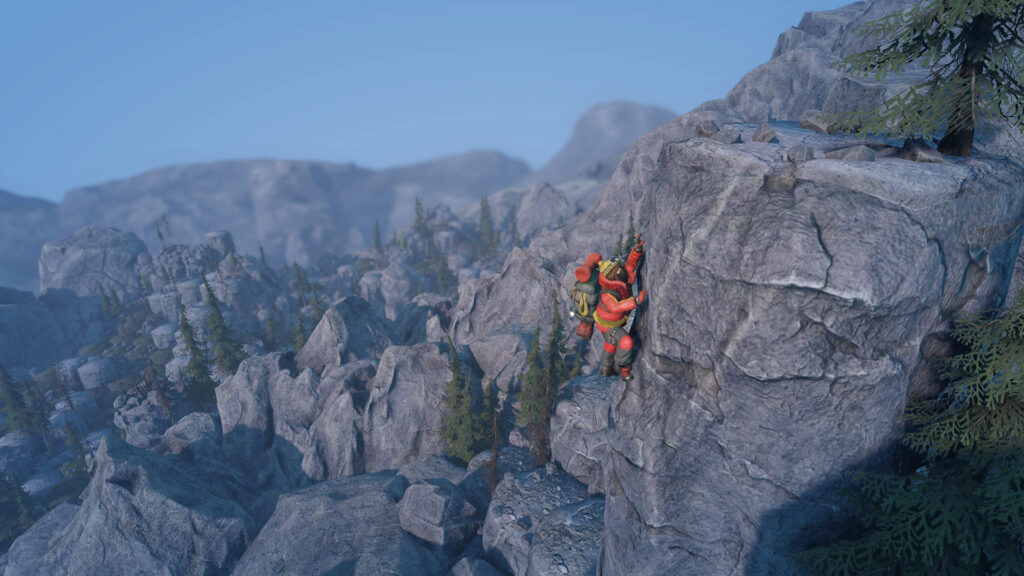
Even before you start a new mountain, you get to pick what route you take. This is where the game integrates procedural generation, by making you pick your own poison. Each route will have its own downsides and if you’re lucky, benefits. One route may be plagued by constant blizzards and storms, and another may have more hostile terrain that will be more taxing on your energy levels. By the time you reach the last mountain, some routes may even feature both of these modifiers. By the end of a run, I was surprised at just how much thought I was putting into each mountain. Before long I was charting out optimal routes, and strategizing when I’d take a breather. It doesn’t hold back when trying to make every playthrough feel like a challenge, which makes reaching that third peak much more rewarding.
In a way, the survival elements of the game offset the simplicity of its other systems. But, at the same time, if its other systems were more developed the game might have been able to reach its full potential. Insurmountable lives up to its name through the integration of its survival mechanics and various modifiers, making every mountain feel like an impossible challenge only the strongest can conquer. Even on the lowest difficulty, you’ll always feel that sense of urgency and intensity towards the end of each level.
Summary
Despite how frequently I ran out of oxygen, Insurmountable still failed to take my breath away. It brings along a lot of interesting tools that it hopes will make the journey as streamlined as possible. Its problem is that it doesn’t take enough time to use them all effectively; underutilising their full capabilities. It delivers on bringing the intense and challenging experience of high stakes mountain climb to your PC, but its lacklustre gameplay systems and bland execution result in a lack of substance, leaving Insurmountable to run out of steam just before it reaches its peak.
Rapid Reviews Rating

3 out of 5
3
You can purchase Insurmountable on Steam right here.

You can find and read our reviews on OpenCritic.





